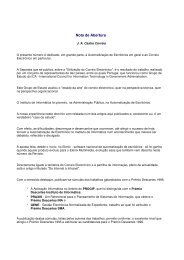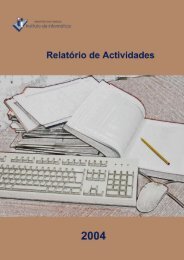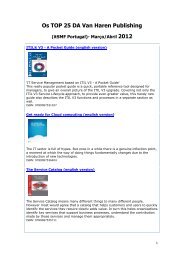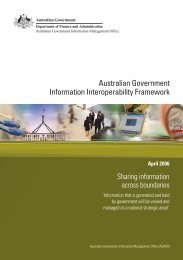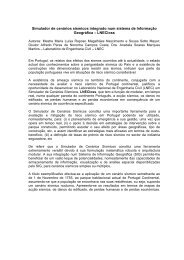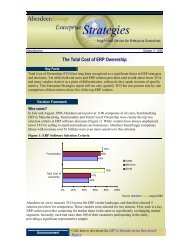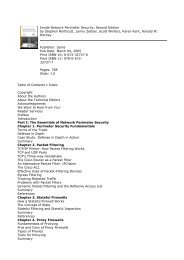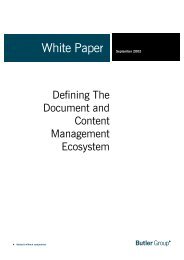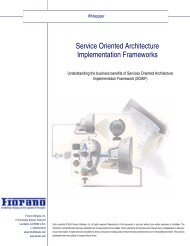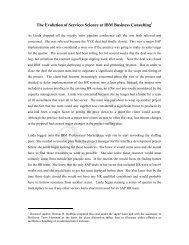OECD Peer Review of E-Government in Denmark - ePractice.eu
OECD Peer Review of E-Government in Denmark - ePractice.eu
OECD Peer Review of E-Government in Denmark - ePractice.eu
Create successful ePaper yourself
Turn your PDF publications into a flip-book with our unique Google optimized e-Paper software.
municipalities, which might otherwise have struggled to develop any e-government capacity. The<br />
creation <strong>of</strong> larger municipalities through the Structural Reform will, however, reduce this as an<br />
argument <strong>in</strong> favour <strong>of</strong> the status quo.<br />
At the time <strong>of</strong> this review, critics <strong>of</strong> the situation with KMD – particularly municipalities and<br />
Danish ICT specialists – focused on two particular issues. First, there was criticism <strong>of</strong> KMD’s ability<br />
to deliver solutions that were compatible with the common e-government frameworks be<strong>in</strong>g developed<br />
<strong>in</strong> <strong>Denmark</strong>. A particular example <strong>of</strong> this is the implementation <strong>of</strong> FESD. <strong>Government</strong> organisations<br />
now face a competitive market for EDM products from three accredited suppliers whose products<br />
meet the FESD EDM <strong>in</strong>teroperability standards. However, adm<strong>in</strong>istrative systems supplied to<br />
municipalities by KMD, <strong>in</strong>clud<strong>in</strong>g an EDM system called EDH, could not be made to <strong>in</strong>teroperate<br />
with FESD-compliant systems. Municipalities were therefore locked <strong>in</strong>to deal<strong>in</strong>g with one supplier,<br />
and the seamless State-local service provision be<strong>in</strong>g sought through e-government was much more<br />
difficult to achieve <strong>in</strong> this area.<br />
It is important to acknowledge that this type <strong>of</strong> problem can arise not only from issues <strong>of</strong> market<br />
structure, but also from the simple fact <strong>of</strong> technological evolution and the challenge <strong>of</strong> ensur<strong>in</strong>g that<br />
ICT systems and applications rema<strong>in</strong> compatible with chang<strong>in</strong>g standards, many <strong>of</strong> which are not <strong>in</strong><br />
existence when systems are developed and put <strong>in</strong>to service (i.e. <strong>in</strong> time, everyth<strong>in</strong>g becomes a legacy<br />
system). It is also important to note that KMD has publicly committed to both develop<strong>in</strong>g future<br />
systems that are compla<strong>in</strong>t with government-wide open standards, and standards-compliant<br />
“gateways” for those legacy systems that cannot be redeveloped. Nonetheless, municipalities’ reliance<br />
on ICT that does not comply with many Danish e-government standards will cont<strong>in</strong>ue to impact on the<br />
e-government programme for the foreseeable future.<br />
The second major criticism expressed about KMD at the time <strong>of</strong> this review relates to the push<br />
towards use <strong>of</strong> so-called “open-source” s<strong>of</strong>tware <strong>in</strong> <strong>Denmark</strong> through the Danish S<strong>of</strong>tware Strategy.<br />
This strategy arose from research undertaken by the Danish Board <strong>of</strong> Technology (an <strong>in</strong>dependent<br />
body established by the Parliament), which <strong>in</strong> late 2002 produced a report entitled Open-source<br />
S<strong>of</strong>tware <strong>in</strong> e-<strong>Government</strong>. The report presented an analysis show<strong>in</strong>g that that the Danish public sector<br />
could save several billion DKK per year by switch<strong>in</strong>g from proprietary (i.e. closed-source) to<br />
open-source s<strong>of</strong>tware.<br />
The result<strong>in</strong>g s<strong>of</strong>tware strategy was put <strong>in</strong> place by the M<strong>in</strong>istry <strong>of</strong> Science, Technology and<br />
Innovation (MVTU) <strong>in</strong> 2003. The overarch<strong>in</strong>g goal <strong>of</strong> this strategy is to foster competition, quality and<br />
coherence <strong>of</strong> the public’s s<strong>of</strong>tware solutions, on the basis <strong>of</strong> the follow<strong>in</strong>g pr<strong>in</strong>ciples:<br />
• Maximum value for money irrespective <strong>of</strong> s<strong>of</strong>tware type.<br />
• Competition, <strong>in</strong>dependence and freedom <strong>of</strong> choice.<br />
• Interoperability and flexibility.<br />
• Development and <strong>in</strong>novation.<br />
In adopt<strong>in</strong>g this strategy <strong>Denmark</strong> has taken a pragmatic approach to the use <strong>of</strong> open-source<br />
s<strong>of</strong>tware <strong>in</strong> government. The strategy expresses no particular preference, <strong>in</strong>stead push<strong>in</strong>g government<br />
organisations to voluntarily choose s<strong>of</strong>tware on the basis <strong>of</strong> how it fits with wider e-government and<br />
economic objectives.<br />
110



